- Hemipolyhedron
-
In geometry, a hemipolyhedron is a uniform star polyhedron some of whose faces pass through its center. These "hemi" faces lie parallel to the faces of some other symmetrical polyhedron, and their count is half the number of faces of that other polyhedron - hence the "hemi" prefix.
The prefix "hemi" is also used to refer to projective polyhedra, such as the hemi-cube, which are the image of a 2 to 1 map of a spherical polyhedron with central symmetry.
Contents
Wythoff symbol and vertex figure
Their Wythoff symbols are of the form p/(p − 1) p | r; their vertex figures are crossed quadrilaterals. The vertex configuration is p·2r·p/(p − 1)·2r. The 2r-gon faces pass through the center of the model. The p/(p − 1) notation implies a convex p-gonal faces turning backwards around the vertex figure. Pentagrams that turn backwards around the vertex figure use a 5/3 notation, while decagrams use a 10/7 notation.
The nine forms, listed with their vertex figures are:
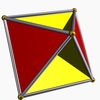
Tetrahemihexahedron
(3.4.3/2.4)
(p = 3, r = 2)
Octahemioctahedron
(3.6.3/2.6)
(p = 3, r = 3)
Small icosihemidodecahedron
(3.10.3/2.10)
(p = 3, r = 5)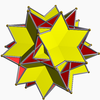
Great icosihemidodecahedron
(10/3.3.10/7.3)
(p = 3, r = 5/3)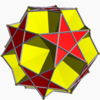
Small dodecahemicosahedron
(5/2.6.5/3.6)
(p = 5/2, r = 3)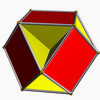
Cubohemioctahedron
(4.6.4/3.6)
(p = 4, r = 3)
Small dodecahemidodecahedron
(5.10.5/4.10)
(p = 5, r = 5)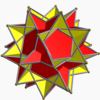
Great dodecahemidodecahedron
(5/2.10/3.5/3.10/3)
(p = 5/2, r = 5/3)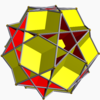
Great dodecahemicosahedron
(5.6.5/4.6)
(p = 5, r = 3)Orientability
Only the octahemioctahedron represents an orientable surface.
Duals of the hemipolyhedra
Since the hemipolyhedra have faces passing through the center, the dual figures have some vertices at infinity; properly, on the real projective plane at infinity, since one wishes to count only one vertex for each pair of prisms going in opposite directions.[1] In Magnus Wenninger's Dual Models, they are represented with intersecting infinite prisms passing through the model center, cut off at a certain point that is convenient for the maker. Wenninger suggested these figures are members of a new class of stellation figures, called stellation to infinity. However, he also acknowledged that strictly speaking they are not polyhedra because their construction does not conform to the usual definitions.
There are 9 such duals, sharing only 5 distinct outward forms, four of them existing in identical pairs. The members of a given pair differ in their arrangements of true vertices vs. points where edges pass through each other. The outwards forms are:
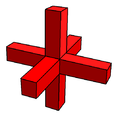


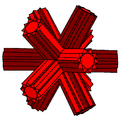
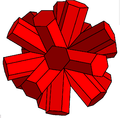
Tetrahemihexacron Octahemioctacron
and hexahemioctacronSmall icosihemidodecacron
and small dodecahemidodecacronGreat dodecahemidodecacron
and great icosihemidodecacronGreat dodecahemicosacron
and small dodecahemicosacron3 intersecting infinite square prisms 4 intersecting infinite hexagonal prisms 6 intersecting infinite decagonal prisms 6 intersecting infinite decagrammic prisms 10 intersecting infinite hexagonal prisms References
- Coxeter, Harold Scott MacDonald; Longuet-Higgins, M. S.; Miller, J. C. P. (1954), "Uniform polyhedra", Philosophical Transactions of the Royal Society of London. Series A. Mathematical and Physical Sciences (The Royal Society) 246 (916): 401–450, doi:10.1098/rsta.1954.0003, ISSN 0080-4614, JSTOR 91532, MR0062446
- Wenninger, Magnus (1974), Polyhedron Models, Cambridge University Press, ISBN 978-0-521-09859-5, MR0467493 (Wenninger models: 67, 68, 78, 89, 91, 100, 102, 106, 107)
- Wenninger, Magnus (1983), Dual Models, Cambridge University Press, ISBN 978-0-521-54325-5, MR730208
- Har'El, Z. Uniform Solution for Uniform Polyhedra., Geometriae Dedicata 47, 57-110, 1993. Zvi Har’El (Page 10, 5.2. Hemi polyhedra p p'|r.)
External links
Categories:- Uniform polyhedra
Wikimedia Foundation. 2010.
